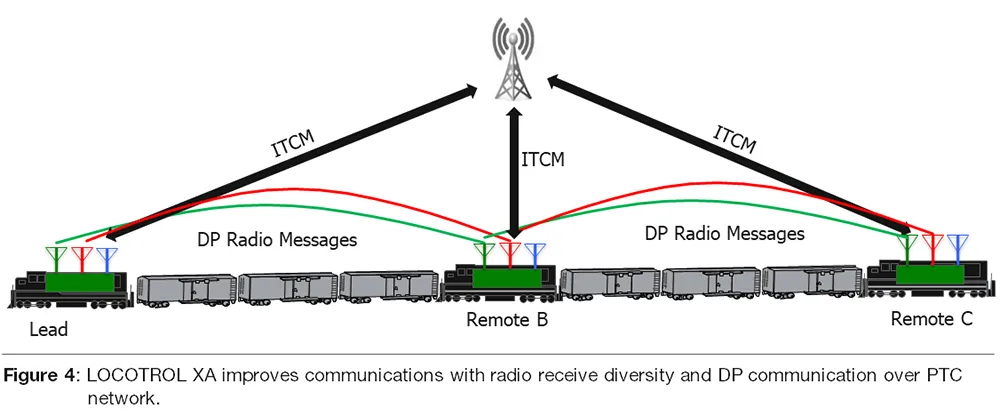By Adam Franco, Adam Hausmann, and Joseph Nazareth
Distributed Power: A Primer
In the drive to increase operational performance, train length has been growing for years. This trend has accelerated recently with the adoption of Precision Scheduled Railroading as an operating strategy to make rail operations more efficient and more profitable.
To meet the demand for longer, heavier trains — and provide efficient train handling — railroads are deploying and utilizing more distributed power systems. Distributed Power (DP) is the practice of placing locomotives at more than one location within a train. Distributed power reduces in-train forces by distributing traction and braking forces along the train. The reduction in lateral forces and friction lowers the impact of heavy trains on track infrastructure, provides better adhesion, and increases fuel efficiency.
The result: trains run more efficiently, safely, and easily.
LOCOTROL® Distributed Power
Wabtec’s LOCOTROL® Distributed Power system was launched over fifty years ago and during that time has become the leading control and communication system, enabling coordinated braking and traction power distribution between lead and remote locomotives on over 21,000 locomotives in 17 countries. The LOCOTROL system has the unique distinction of enabling the operation of the world’s longest and heaviest train – approx. 4.5 miles (7.3 kilometers) long, weighing 99,732 tons, with 8 locomotives hauling 682 ore cars – and the solution continues to evolve with new functionality to meet important industry needs.
Today, the LOCOTROL system interfaces with almost every type of braking system and locomotive control system and serves as the platform for future train automation for advanced train operations.
Distributed Power Challenges
Distributed power locomotives are remotely controlled by the crew from the lead locomotive. This requires radio communication between the lead and remote locomotives. There are times when the radio communications path is not available, especially considering the fact that railroads operate in remote areas across all types of terrain, including mountains, forests, hills, valleys, and tunnels. The result: dead spots. These dead zones can be significant, representing hundreds of minutes on a train run. When a communication interruption occurs, the lead locomotive displays the last status of the remotes. During the time of the interruption, the lead locomotive cannot communicate commands to the remotes, which continue to operate the last function commanded prior to the communication loss.
Ultimately, the ability to minimize communication losses helps train handling (the remotes can respond to what is being commanded by the lead) and it increases fuel efficiency (the train remains in Trip Optimizer auto control longer).
So, how do railroads reduce communication losses and maximize the value of distributed power? The technology is already here.
Advancements in Next Generation Distributed Power Technology: LOCOTROL XA
The 6th generation of the LOCOTROL Distributed Power platform is called LOCOTROL® XA, for eXpanded Architecture. It improves communication in several powerful ways:
- Dual-radio receive diversity facilitates a 50% reduction in Distributed Power communication loss, enabling trains to run at track speed more frequently and driving velocity improvements across the network.
- DP messages over the ITCM network (PTC network) provides additional communication options (220 MHz, Cell, Wi-Fi) and higher data bandwidth, as a backup to the radio network. This powerful new feature is proving to be a great way to gain communication when radio is not available.
- Integrated HOT & mid-train HOT/EOT repeating reduces EOT communication losses and enables longer trains that run at track speeds more frequently.
- Triple HOT redundancy with DP radios serving as alternative HOT radio.
- Enhanced diagnostics provide the crew with greater insight to ensure mission success.
Conclusion
LOCOTROL XA’s advanced communication features, including radio diversity, integrated HOT/EOT repeating, and radio backup with DP messages over the PTC network, ensure that communication losses are minimized and the value of Distributed Power trains is maximized. The result:
- Increased train hauling capacity
- Improved train handling
- Increased fuel efficiency
- Increased network velocity
- Reduced variability
- Reduced costs; higher productivity
About the Authors:
Adam Franco is the Senior Digital Product Manager for LOCOTROL Distributed Power and Remote Control at Wabtec. He is currently focused on delivering higher level of operational efficiency and fuel efficiency through remote control and drone control.
Adam Hausmann is the Senior Digital Product Manager for LOCOTROL Distributed Power and Remote Control at Wabtec. Utilizing his Systems Engineering background, he works closely with customers to ensure that LOCOTROL XA unlocks value and propels the rail industry to new heights of operational performance.
Joseph Nazareth is the LOCOTROL Product Line Leader at Wabtec. Joe is passionate about developing remote control solutions that improve the productivity and efficiency of freight train operations and has over 20 years of experience in doing so.








